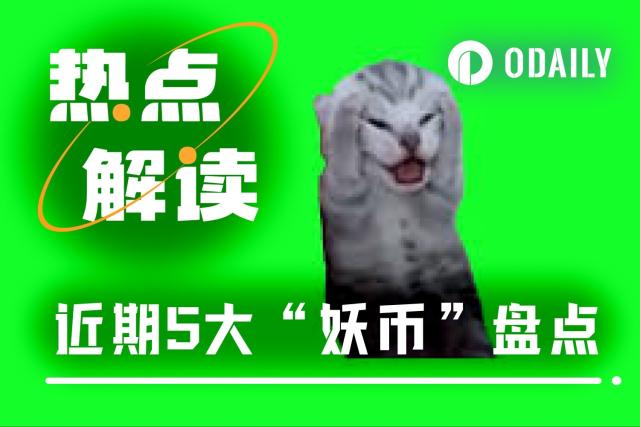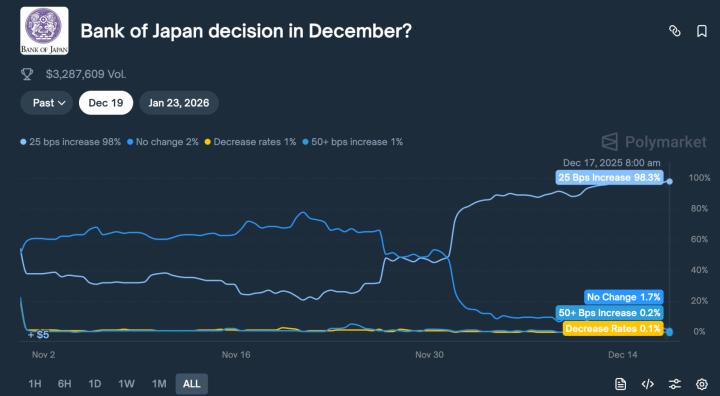On January 25 this year, the Sui Foundation Developer Funding Program announced the 12 projects that received funding in the first round. These projects will receive funding amounts ranging from US$20,000 to US$75,000. As a first-round and pilot funding program, the Sui Foundation has its sights set on developer tools, DeFi, security, and more, projects that showcase innovative open source solutions that benefit the Sui ecosystem. The following is a brief introduction to the specific information of these 12 projects.
Dappium: A decentralized no-code platform
Using Dappium, developers can convert existing games into Web3 games without any knowledge of blockchain technology. Dappium includes an API and Web2 SDK to automatically develop, create and deploy smart contracts. It enables interoperability, offers fiat-friendly options, hybrid models, and more. Developers only need to fill out the form to get tips and tutorials and complete the following functions: Create tokens for games or companies.
- Generate and mint NFT items and collectibles, creating an in-game NFT marketplace. Supports uploading asset files and metadata via zip files.
- Design and deploy tokenomics, in-game token metrics and staking, sweepstakes, etc.
- Implement wallet integration with escrow and fiat-friendly options.
- Create DAOs.
- Support Solidity and Rust covering most of the mainnet.
The project was developed by the team that won the Avalanche Hackathon and has been audited by Certik and Hacken.
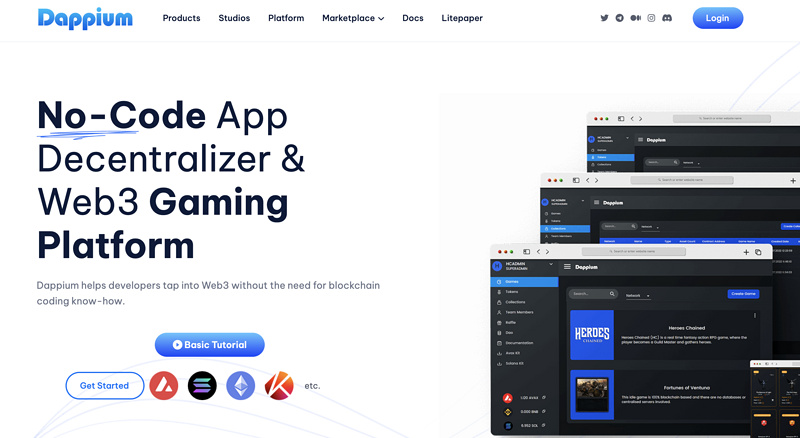
Dapp Low Code Dev Platform: A low-code platform that can improve development efficiency
A low-code development platform refers to allowing developers to efficiently build extremely complex decentralized applications with an experience very close to developing "traditional" applications. Dapp Low Code Dev Platform expects to provide developers with a simple Web IDE for writing business logic codes, generating Dapp applications with "one-click" and deploying applications to the cloud testing environment.
In the initial phase, the platform will prioritize support for Dapps built on the Move blockchain. But in the later operation, developers will not be restricted from using any programming language to build Dapp. In addition, using the Dapp Low Code Dev Platform in a suitable place for "low code" development can increase development efficiency by more than ten times. This makes it easier for developers of "traditional" applications to enjoy the dividends of blockchain development; and highly complex "traditional" enterprise software and Web 2.0 Internet applications can also be migrated to the chain at low cost, becoming Decentralized Web 3.0 applications.
It is expected that within two or three months after the project is launched, the platform will create a command-line tool or tool set that can help developers generate on-chain Move contracts (the on-chain part of Dapp) and off-chain services (using Java or Go language), and even generate more things, such as JavaScript Client SDK, scaffolding code for web front-end applications with user interface, etc. In the second stage, the team will move the functions of the command-line tool created in the first stage to the cloud, and developers only need to open a browser to use it. The team expects to provide a simple Web IDE for developers to write model codes, generate Dapp applications with one click, and deploy applications to the cloud testing environment.
Go Sui SDK: A Web3 platform that combines multiple development functions
This Sui Golang SDK for ComingChat is a Web3 platform that combines account system, payment tools, and social features to help developers build new applications in a full-featured ecosystem. Go developers can also take advantage of ComingChat's Sui NFT platform and full-chain wallet functions to provide gamers on Sui with a place for game props and NFT transactions.
ComingChat is a social application on SUI, which combines encrypted communication, social networking, wallet, NFT, decentralized digital identity, full chain exchange, bitcoin lending, etc. It mainly solves three problems: people, money and social network, and provides the foundation for DeFi and GameFi.

Movey: Language Pack Manager for Move
Movey, developed by East Agile, is a registry of Move language packs for Move developers to discover, validate, and collaborate on Move language packs. The current version of Movey integrates Move CLI, and developers can interact with Movey through the official Move CLI.
Movey plans to:
- Verify the package by comparing on-chain and off-chain.
- Enables the community to improve and enhance the content on Movey.

Remix IDE Plugin: A plugin for writing Sui smart contracts
Remix IDE Plugin is a plugin for WELLDONE Studio development tool WELLDONE Code. WELLDONE Code can provide developers in any blockchain ecosystem with the ability to write smart contracts without having to build a separate development environment. Specifically, Remix is a web-based integrated development environment (IDE) for the Solidity programming language for writing smart contracts for the Ethereum blockchain. Remix allows developers to write, test and debug EVM-based smart contracts in a convenient and user-friendly interface. Using the plugin, developers can easily develop and test smart contracts for non-EVM networks such as NEAR and Cosmos as well as EVM-compatible networks in the Remix IDE.
Currently, the plugin is extended to support the Sui ecosystem, allowing developers to use Remix IDE to write Sui smart contracts, which will help more developers quickly get started with Sui smart contracts without having to build a separate development environment.

Sui Move Analyzer: A plugin that provides support for the Move language
Sui Move Analyzer is built on MoveBit and provides language support for Sui Move + Move. It will also provide project templates, support for Sui unit testing, and support for Sui Move Prover.
MoveBit is a blockchain security company focusing on Move ecological security. The team consists of security leaders from academia and enterprise with 10 years of security experience. The team was one of the earliest contributors to the Move ecosystem, working with Move developers to set the standard for Move secure apps.

Keepsake: The NFT Marketplace Ecosystem
Keepsake is a future-proof NFT marketplace ecosystem built for game developers, gamers, creators and their communities. The Keepsake marketplace allows for game SDK integration for seamless play and listing assets directly from within the game. Additionally, each Keepsake NFT can be converted into physical assets such as collectibles, figurines, plush toys, and more.
At present, the Keepsake market has established a cooperative relationship with SuiNS, the SUI domain name service, and users can directly purchase SuiNS domain names in Keepsake. In the later cooperation, players will also be allowed to register SuiNS instantly on the page.
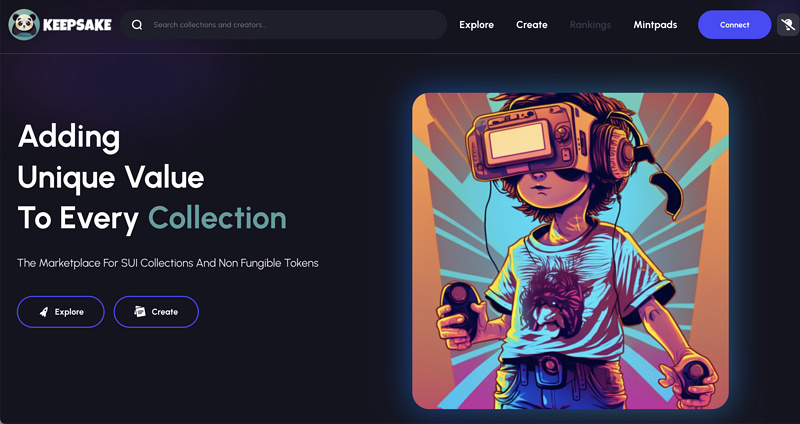
AirPay: Combining on-chain assets and activities with local legal currency
The AirPay service issues debit cards to Sui token holders, allowing them to seamlessly pay for services or goods at any store with an NFC point-of-sale system. Users do not need a bank or central exchange account, as AirPay converts tokens directly into fiat currency.
advantage:
- No need to exchange tokens for other tokens.
- No need to open a bank account.
- No need for a centralized exchange account.
- Transactions are completed in less than 5 seconds.
Upcoming features:
- Collateral NFT for local currency (10-30% of reserve price).
- Receive promotions and deals from various merchants and retailers through agreements. Use promotions with AIR tokens as discounts.
- Seamlessly pay online services and merchants (Amazon, Uber, eBay).
- Automatically pay different bills (electricity, water, gas, Wifi, mobile) using tokens.
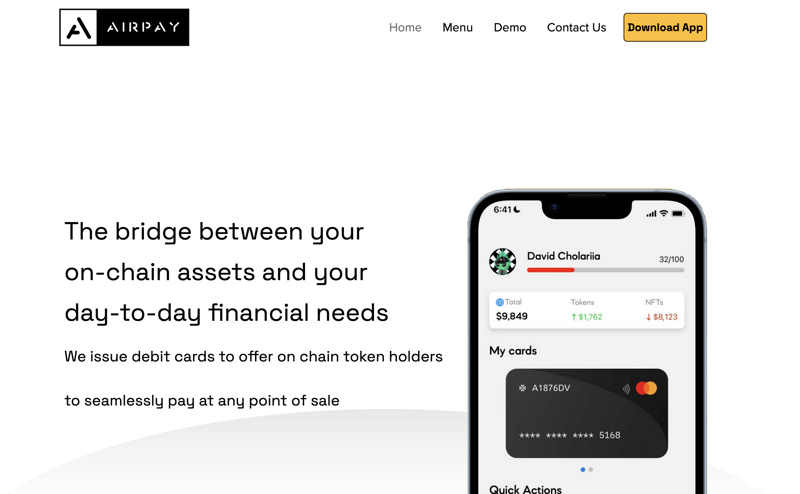
Suia: The first POAP on the Sui chain
Suia is the first POAP (proof of attendance) application on the Sui chain, developed by the NFT application developer Mynft team. It has been released on the devnet on the SUI chain. In the future, Suia will have multiple uses, such as event tickets, contribution medals, games, etc., to build a new immersive and gamified interaction between Web3 brands and users.
advantage:
Anyone can create POAP events through Suia, and all creation and distribution are carried out on the SUI chain, which is open and transparent. Users own the ownership of Suia assets, and the unique architecture and parallel running performance of the Sui chain can give Suia the opportunity to combine and create more other gameplays and allow large-scale user participation, which can achieve low latency and low cost, and is easy to connect The application market of Web2.
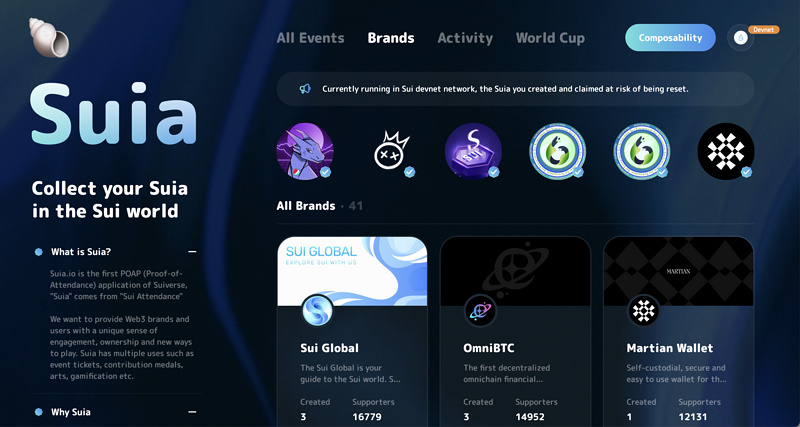
All.Art: A metaverse dedicated to art and culture
All.Art is a metaverse dedicated to the field of art and culture, a virtual reality world of exhibitions for artists, galleries, museums, collectors, educational institutions and companies. All.Art NFT's open-source Unity-Sui wallet allows users and artists to seamlessly trade NFTs.
All.Art's virtual reality platform has been in development since 2017 and has been working in the field of art and culture. 25 galleries and more than 250 artworks were exhibited at the All.Art Metaverse digital art fair. Provides the best VR experience for artists, gallerists, curators, collectors and art lovers.

Mamoru: Security Monitoring Program
Toshi's Mamoru platform is an instant detection solution for security and operational monitoring of blockchain activity. Provide automated and secure smart contract operations for applications built on the Sui blockchain. It is capable of monitoring and responding to smart contract exploits in near-instantaneity. Its Alpha version provides an interface to define contract monitoring rules, and the beta version will add support for machine learning.
Toshi Fund I is a Move ecosystem fund investing in Move's technology founders.
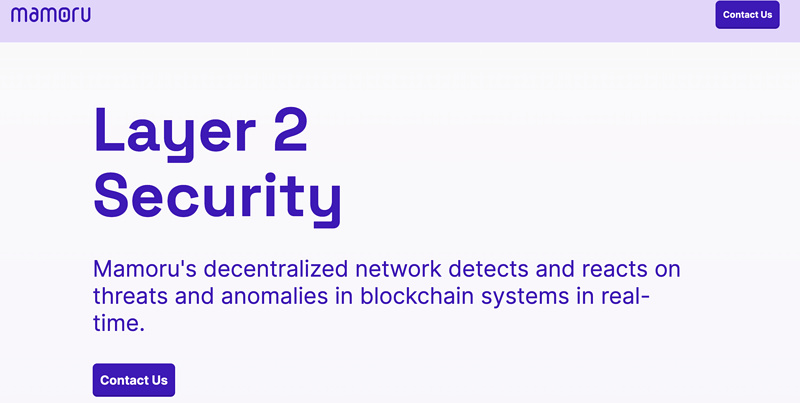
Scallop: Senior Bond Protocol
Scallop was originally a senior bond protocol on Solana that maximized potential yield without losing principal. It will now also be extended to Rust/Move blockchains such as Aptos and Sui. Users can deposit tokens on Scallop's asset pool, and Scallop will use functions such as lending, staking, and stable pool liquidity mining to earn income for users. Scallop calls the verifiable random function on the chain every day, and selects a winner in each liquidity pool to get all the benefits, and other benefits will be kept in the Scallop treasury and governed by the community.
Scallop has a user dashboard called Scallop Tank and an on-chain collection called Scallop Decorations. Scallop Decorations will appear in Scallop Tank and interact with the Scallop protocol. These features make Scallop more unique.
Scallop launched a Devnet beta in April 2022, and the mainnet went live in August 2022.






